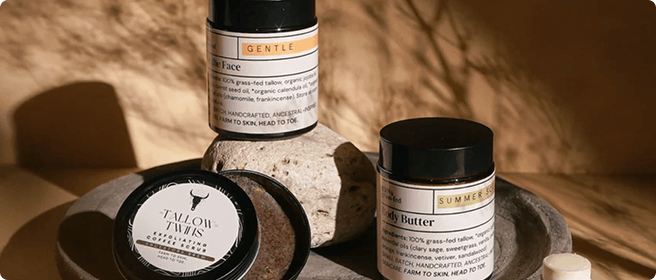It’s Time to Go Non-Toxic
Deodorant is one of those products most of us reach for daily without giving it much thought. But beneath the promise of freshness and sweat protection lies a world of potentially harmful chemicals that most people never consider a danger to their health and hormones.
We create non-toxic wellness products, so naturally, our philosophy is simple: what you put on your body should support your body. When it comes to deodorants, this principle is totally ignored. Most commercial deodorants and antiperspirants are loaded with ingredients that may pose risks to your health, disrupt your hormones, and irritate your skin. Non-toxic alternatives are not just desirable but necessary.
To be the first to get our tallow deodorant (and before it sells out), subscribe to our newsletter.
Understanding What’s in Your Deodorant and Why It Matters
The cosmetic industry is vast, but deodorants have a surprisingly consistent list of ingredients that raise red flags among scientists and health advocates. From aluminum compounds to synthetic fragrances, these chemicals can have wide-ranging effects on the body.
Aluminum Compounds: The Controversial Sweat Blockers
Aluminum-based compounds such as aluminum chlorohydrate and aluminum zirconium are the active ingredients in most antiperspirants. They work by temporarily blocking sweat glands, preventing sweat from reaching the skin’s surface.
While this mechanism might sound effective, it interferes with one of the body’s natural detoxification pathways. Sweat is one way our bodies eliminate toxins, regulate temperature, and maintain skin health.
Beyond that, aluminum absorption through the skin has been linked, though the research is ongoing-to serious health concerns. Studies have found aluminum deposits in breast tissue and even in the brains of patients with Alzheimer’s disease. A 2001 review by Christopher Exley, a leading researcher in aluminum toxicology, concluded that aluminum exposure might play a role in the development of neurodegenerative diseases. Although direct causation remains debated, the precautionary principle suggests limiting aluminum exposure wherever possible.
The underarm area is unique because it has thin skin and is home to numerous lymph nodes. This proximity raises concerns about aluminum’s potential to disrupt lymphatic function and hormone balance.
Synthetic Fragrances
The word “fragrance” or “parfum” on ingredient lists often conceals a cocktail of hundreds of undisclosed chemicals. Among these are phthalates: plasticizing agents known to interfere with the endocrine system.
Phthalates have been implicated in lowered testosterone levels, reproductive abnormalities, and developmental issues in children. A 2015 review published in *Environmental Health Perspectives* highlighted the ubiquity of phthalates in personal care products and their potential to disrupt hormonal health.
Because the fragrance industry is largely unregulated, consumers are rarely informed of the actual substances they are applying daily to their skin.
Triclosan
Triclosan is an antimicrobial compound historically used in deodorants and antibacterial soaps to reduce odour-causing bacteria. Despite its widespread use, the FDA banned triclosan in hand soaps in 2016 due to concerns over hormone disruption and antibiotic resistance, but it remains permitted in some deodorant formulations.
Triclosan’s interference with thyroid hormone homeostasis and its potential to contribute to antibiotic-resistant bacteria make it a worrying inclusion in products intended for daily use.
Propylene Glycol and Parabens
Propylene glycol acts as a penetration enhancer, allowing other chemicals to be absorbed more deeply into the skin, potentially increasing systemic exposure to toxins.
Parabens, commonly used preservatives, mimic estrogen by binding to estrogen receptors. Research has detected parabens in human breast tumours, leading to concerns about their role in hormone-related cancers.
The Underarm: A Vulnerable Absorption Site
The skin under the arms is thinner and more permeable than other areas. It’s rich in sweat glands and lymph nodes, which are crucial components of the immune system. This means toxins applied here can enter the bloodstream more readily and interact with the body’s hormonal and immune systems.
Research shows that compounds applied topically in this region can be absorbed and accumulate in tissues. A 2004 study published in *Journal of Inorganic Biochemistry* found elevated aluminum levels in the breast tissue of women who regularly used antiperspirants.
This localized exposure underscores the need for caution with products applied under the arms.
Deodorant and Cancer: What Does the Research Say?
One of the most pressing concerns about conventional deodorants and antiperspirants is their possible link to cancer, particularly breast cancer. While the scientific community hasn’t reached a unanimous consensus, a growing body of research has raised enough questions to warrant serious attention.
The Breast Tissue Connection
Commercial deodorants and antiperspirants are applied directly to the underarm area, which is adjacent to the upper outer quadrant of the breast—the very region where the majority of breast cancers are diagnosed. This proximity alone doesn’t prove causation, but it does raise an important question: could repeated, long-term exposure to certain ingredients influence cellular changes in nearby tissue?
Aluminum and Breast Tissue
As discussed earlier, aluminum compounds are common in antiperspirants because they temporarily plug sweat ducts, reducing perspiration. However, studies have shown that aluminum can be absorbed through the skin, especially when applied to freshly shaved underarms, where microabrasions can increase permeability.
A study published in the Journal of Inorganic Biochemistry detected measurable concentrations of aluminum in breast tissue, with the highest levels found closest to the underarm area. The researchers suggested that this pattern could point to absorption from external products, such as deodorants.
Aluminum is known to have estrogen-like effects, which is notable because estrogen can promote the growth of certain breast cancer cells. While aluminum is not officially classified as a carcinogen, its hormonal activity has led some scientists to caution against its daily, long-term application near hormone-sensitive tissues.
“Estrogen is known to influence the growth and differentiation of breast tissue, and some aluminum compounds have been shown to have estrogenic activity in human breast cancer cells.”
— Darbre, P.D. et al., Journal of Applied Toxicology, 2005
Debunking the Sweat and Odour Myth
Sweat itself is odourless. The unpleasant smell associated with underarm sweat arises when bacteria on the skin metabolize sweat components into volatile compounds.
Interestingly, the microbiome (the community of bacteria living on your skin) plays a critical role in body odour. Disrupting this delicate ecosystem with harsh chemicals or overuse of antibacterial agents can paradoxically increase odour over time.
Maintaining a balanced microbiome with gentle, natural products supports odour control and overall skin health.
Why "Natural" Deodorants Often Fall Short
In recent years, natural deodorants have surged in popularity. However, many formulations rely heavily on baking soda (sodium bicarbonate) for odour control. While effective at neutralizing odour, baking soda can cause irritation, redness, and rash in sensitive individuals.
Many natural deodorants lack ingredients that support skin barrier repair and nourishment, focusing only on masking odour rather than promoting skin health.
The Case for Tallow-Based Deodorants: Nourishing Your Skin as You Protect It
This is where tallow stands apart. Traditionally used in ancestral skincare, tallow is rendered animal fat rich in fat-soluble vitamins (A, D, E, and K) and essential fatty acids that mirror the skin’s natural sebum.
Scientific Benefits of Tallow in Skincare
Skin Barrier Support: The fatty acid profile of tallow closely resembles the skin’s own lipids, making it highly bioavailable and effective at repairing and strengthening the skin barrier. A healthy skin barrier is essential for moisture retention and protection against irritants.
Anti-Inflammatory Properties: Vitamins A and D found in tallow contribute to reducing inflammation and promoting skin regeneration. Clinical dermatology recognizes Vitamin A derivatives (retinoids) as beneficial for skin health.
Antimicrobial Effects: Tallow contains natural antimicrobial agents that can support a balanced skin microbiome, helping to inhibit odour-causing bacteria without the harsh effects of synthetic antibacterials.
Non-Comedogenic and Breathable: Unlike heavy oils or synthetic occlusives, tallow nourishes the skin without clogging pores or obstructing sweat glands.
Why This Matters in a Deodorant
Most deodorants focus solely on odour masking or sweat blocking, often at the expense of skin health. Tallow-based deodorants nourish, protect, and work in harmony with your body’s biology. They support the skin’s natural ability to manage sweat and odour while maintaining barrier integrity and reducing irritation.
Our Tallow-Based Deodorant: A New Standard in Natural Care
After months of research and formulation, we are proud to announce the forthcoming launch of our tallow-based deodorant. Crafted with intention and informed by science, this product will offer:
* Effective, long-lasting odour control without harmful chemicals
* Skin-nourishing ingredients that promote barrier repair
* Non-toxic components free from aluminum, parabens, synthetic fragrances, and harsh antibacterials
* A formula that respects the delicate balance of your skin’s microbiome
We believe this is more than a deodorant; it’s a return to mindful self-care.
Why Detoxing Your Deodorant Routine Is Essential
As more consumers become aware of the links between personal care products and long-term health, the importance of detoxifying your routine cannot be overstated.
The underarm is a high-absorption zone applied to multiple times daily, often starting in early adolescence, a critical time for hormonal development. Choosing products free from endocrine disruptors is a vital step in protecting your health and honouring your body’s natural processes.
The Future of Deodorant is Nourishing and Natural
The traditional approach to deodorants and antiperspirants has relied heavily on chemical intervention and masking. The science, however, points to the drawbacks of these methods, from hormone disruption to skin damage.
Tallow offers an elegant, science-backed solution. By supporting skin health and respecting the body’s natural detox pathways, a tallow-based deodorant represents a thoughtful evolution in personal care.
If you’re ready to move beyond the outdated, potentially harmful formulas dominating the market, keep an eye out for our upcoming launch. A new era of deodorant; one that works, nourishes, and protects, is on the horizon.
To get it first (and before it sells out), subscribe to our newsletter.




